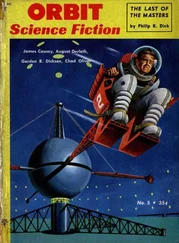Of course, he and Fay had been quarreling a lot, as usual, and that may have had something to do with it. When he got mad he had no control over the language he used, and Fay has always been the same way—not merely using gutter words, but in the indiscriminate choice of insults, harping on each other’s weak points and saying anything that might hurt, whether true or not—in other words, saying anything, and very loud, so that their two children got quite an earful. Even in his normal conversation Charley has always been foulmouthed, which is something you might expect from a man who grew up in a town in Colorado. Fay always enjoyed his language. The two of them made quite a pair. I remember one day when the three of us were out on their patio, enjoying the sun, when I happened to say something, I think having to do with space travel, and Charley said to me,
“Isidore, you sure are a crap artist.”
Fay laughed, because it made me so sore. It made no difference to her that I was her brother; she didn’t care who Charley insulted. The irony of a slob like that, a paunchy, beer-drinking ignorant mid-westener who never got through high school, calling me a “crap artist” lingered in my mind and caused me to select the ironic title that I have on this work. I can just see all the Charley Humes in the world, with their portable radios tuned to the Giants’ ballgames, a big cigar sticking out of their mouth, that slack, vacant expression on their fat red faces… and it’s slobs like that who’re running this country and its major businesses and its army and navy, in fact everything. It’s a perpetual mystery to me. Charley only employed seven guys at his iron works, but think of that: seven human beings dependent on a farmer like that for their very livelihood. A man like that in a position to blow his nose on the rest of us, on anybody who has sensitivity or talent.
Their house, up in Marin County, cost them a lot of money because they built it themselves. They bought ten acres of land back in 1951, when they first got married, and then, while they were living in Petaluma where Charley’s factory is, they hired an architect and got their plans drawn up for their house.
In my opinion, Fay’s whole motive for getting mixed up with a man like that in the first place was to finally wind up with a house such as she did wind up with. After all, when he met her he already owned his factory and netted a good forty thousand a year (at least to hear him tell it). Our family had never had any money; we ate off a set of dime store blue willow for ten years, and I don’t think my father ever owned a new suit at any time in his life. Of course, by winning a scholarship and being able to go on to college, Fay started meeting men from good homes—the frat boys who always horse around with big-game bonfires and the like. For a year or so she went steady with a boy studying to be a law student, a fairy-like creature who never did appeal much to me, although he liked to play pin ball machines—to learn the mathematical odds, as he explained it. Charley met her by chance, in a roadside grocery store on highway One near Fort Ross. She was ahead of him in line, buying hamburger buns and Coca-Cola and cigarettes, and humming a Mozart tune which she had learned in a college music course. Charley thought it was an old hymn that he had sung back in Canon City, Colorado, and he started talking to her. Outside the grocery store he had his Mercedes-Benz car parked, and she could see it, with that three-point star sticking up from the radiator. Naturally Charley had on his Mercedes-Benz pin, sticking out of his shirt, so she and the rest of the world could see whose car it was. And she had always wanted a good car, especially a foreign one.
As I construct it, based on my fairly thorough knowledge of both of them, the conversation went like this:
“Is that car out there a six or an eight?” Fay asked him.
“A six,” Charley said.
“Good god,” Fay said, “Only a six?”
“Even the Rolls Royce is a six,” Charley said. “Those Europeans don’t make eights. What do you need eight cylinders for?”
“Good god. The Rolls Royce a six.”
All her life Fay had wanted to ride in a Rolls Royce. She had seen one once, parked at the curb by a fancy restaurant in San Francisco. The three of us, she and I and Charley, walked all around it.
“That’s a terrific car,” Charley said, and proceeded to give us details on how it worked. I couldn’t have cared less. If I had my choice I’d like a Thunderbird or a Corvette. Fay listened to him as we walked on, and I could see that she wasn’t too interested either. Something had distressed her.
“They’re so flashy-looking,” she said. “I always thought of a Rolls as a classic-looking car. Like a World War One military sedan. An officers’ car.”
Consider to yourself if you’ve ever actually seen a new Rolls. They’re small, metallic, streamlined but also chunky. Heavy-looking. Like some of the Jaguar saloon models, only more impressive. British streamlining, if you get the picture. Personally I wouldn’t have one on a bet, and I could see that Fay was wrestling with the same reaction. This one had a silver-blue finish, with lots of chrome. In fact the whole car had a polished look, and this appealed to Charley, who liked metal and not wood or plastic.
“There’s a real car,” he said. Obviously he could see that he wasn’t getting across to either of us; all he could do was repeat himself in his customary clumsy way. Besides his gutter words he had the vocabulary of a six year old, just a few words to cover everything. “That’s a car,” he said finally, as we got to the house we had come to San Francisco to visit. “But it would look out of place in Petaluma.”
“Especially parked in the lot at your plant,” I said.
Fay said, “What a waste it would be—putting all that money into a car. Twelve thousand dollars.”
“Hell, I could pick up one for a lot less,” Charley said. “I know the guy who runs the British Motor Car agency down here.”
No doubt he wanted the car, and, left to himself, he possibly would have bought it. But their money had to go into their house, whether Charley liked it or not. Fay wouldn’t let him buy any more cars. He had owned, besides the Mercedes, a Triumph and a Studebaker Golden Hawk, and of course several trucks for the business. Fay had told the architect to put radiant heating into the house, the resistance wire type, and up in the country where they were, it would cost them a fortune in electricity. Everyone else up there uses Butane or burns wood. On the cow pasture Fay was having a swanky modern San Francisco type of house built, with recessed bath tubs, plenty of tile and mahogany panelling, fluorescent lighting, custom kitchen, electric washer and drier combination—the works, including a custom hi-fl combination with speakers built right into the walls. The house had a glass side looking out onto the acres, and a fireplace in the center of the living room, a circular barbecue type with a huge black chimney stuck over it. Naturally the floor had to be asphalt tile, in case logs rolled out. Fay had four bedrooms built, plus a study that could be used by guests. Three bathrooms in all, one for the children, one for guests, one for herself and Charley. And a sewing rooni, a utility room, a family room, dining room—even a room for the freezer. And of course a tv room.
The whole house rested on a concrete slab. That, and the asphalt tile, made it so cold that the radiant heating could never be shut off except in the hottest part of summer. If you shut it off when you went to bed, by morning the house was like a cold-storage vault. After it had been built, and Charley and Fay and the two children had moved into it, they discovered that even with the fireplace and radiant heating the house was cold from October through April, and that during the wet season the water failed to drain off the soil, and, instead, seeped into the house around the frames holding the glass and under the doors. For two months in 1955 the house sat in a pool of water. A contractor had to come out and build a whole new drainage system to carry water away from the house. And in 1956 they put 220 volt wall heaters with manual switches and thermostats both into every room of the house; the damp and cold had begun to mildew all the clothes and the sheets on the beds. They also found that in winter the electric power was interrupted for several days on end, and during that time they could not cook on the electric stove, and the pump that pumped their water, being electric, failed to pump; the water heater was electric, too, so that everything had to be cooked and heated over the fireplace. Fay even had to wash clothes in a zinc bucket propped up in the fireplace. And all four of them got the flu every winter that they lived up there. They had three separate heating systems, and yet the house remained drafty; for instance, the long hall between the children’s rooms and the front part of the house had no heat at all, and when the kids came scampering out in their pajamas at night they had to go from their warm rooms into the cold and then back into the heat of the living room again. And they did that every night at least six times.
Читать дальше










